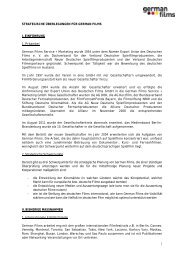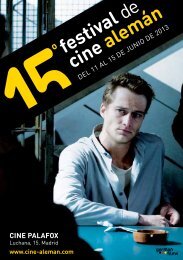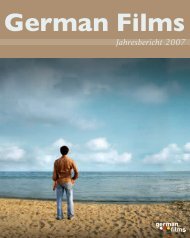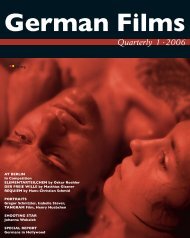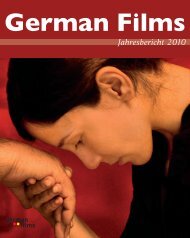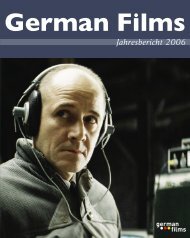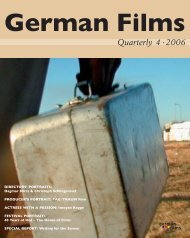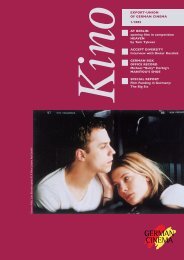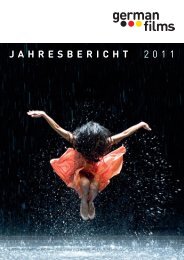cover 4_05-gfq.RV - German Films
cover 4_05-gfq.RV - German Films
cover 4_05-gfq.RV - German Films
You also want an ePaper? Increase the reach of your titles
YUMPU automatically turns print PDFs into web optimized ePapers that Google loves.
out her longings and erotic desires knowing at the same time that she<br />
is in safety. But this game turns serious when the prisoner breaks out<br />
of prison and seeks refuge in the woman’s flat. An ambivalent<br />
relationship marked by fear, hatred and the longing for mutual respect<br />
and love develops between these two totally different people. As<br />
time goes by, Irene increasingly loses control over her feelings. When<br />
the police track the fugitive down to her flat, she is prepared to give<br />
up the life she has led until then and run away with him. And it seems<br />
that a new life will begin for them both …<br />
“The love story develops very slowly with a typical ’Iain Dilthey-female<br />
character’,” Haag explains. “This slow and precise narrative<br />
form will be somewhat more dramatic than in his previous films, but<br />
Gefangene is basically all about the tension between the two main<br />
characters.”<br />
As Haag observes, an important stage began before the actual shooting<br />
when Dilthey spent time with the three actors on the fine-tuning<br />
of the screenplay and rehearsing their parts. Andreas Schmidt is<br />
known to cinema audiences especially from the films of Eoin Moore<br />
like Conemara, Pigs Will Fly or Im Schwitzkasten since he is a regular<br />
collaborator with the Irish-born filmmaker and most recently he<br />
appeared in Andreas Dresen’s Sommer vorm Balkon. Jule Boewe<br />
came to greater prominence in Florian Schwarz’s Katze im Sack which<br />
was shown in the Perspektive Deutsches Kino section at this year’s<br />
Berlinale. And Eva Loebau (who appears as a friend of Irene’s) was<br />
in Dilthey’s Ich werde Dich auf Haenden tragen and was the female<br />
lead in Maren Ade’s prize-winning Der Wald vor lauter Baeumen.<br />
Ich bin die Andere<br />
Scene from “Ich bin die Andere”<br />
(photo courtesy of Clasart Filmproduktion)<br />
Type of Project Feature Film Cinema Genre Drama, Literature,<br />
Love Story, Psycho-Thriller Production Company Clasart<br />
Filmproduktion/Munich With backing from FilmFernsehFonds<br />
Bayern, Filmfoerderungsanstalt (FFA), HessenInvest Producer<br />
Markus Zimmer Director Margarethe von Trotta Screenplay<br />
Peter Maerthesheimer, Pea Froehlich Director of Photography<br />
Axel Block Editor Corinna Dietz Music by Chris Heyne<br />
Production Design Uwe Max Szielasko Principal Cast Katja<br />
Riemann, August Diehl, Armin Mueller-Stahl, Barbara Auer, Karin Dor<br />
Casting Sabine Schroth Special Effects CA Scanline/Geiselgasteig<br />
Format Super 35 mm, color, cs, Dolby Stereo Shooting<br />
Language <strong>German</strong> Shooting in Munich, Frankfurt am Main,<br />
MB<br />
Asmannshausen, Casablanca, June-July 20<strong>05</strong> <strong>German</strong> Distributor<br />
Concorde Filmverleih/Munich<br />
World Sales<br />
StudioCanal · Muriel Sauzay<br />
5, Boulevard de la Republique<br />
92514 Boulogne-Billancourt/France<br />
phone +33-1-71 75 85 00 · fax +33-1-71 75 89 73<br />
email: msauzay@studiocanal.com<br />
www.studiocanal.com<br />
Five years ago, Clasart Film’s Markus Zimmer met the late<br />
Peter Maerthesheimer – who tragically died from a heart attack at a<br />
session of the Deutsche Filmakademie in June 2004 – at an event dedicated<br />
to Rainer Werner Fassbinder where he heard about<br />
Maerthesheimer’s new novel Ich bin die Andere which centers on a<br />
young woman suffering from schizophrenia.<br />
After reading the novel, Zimmer was enthusiastic about having the<br />
novel adapted for the cinema, but another company had already<br />
optioned the film rights. However, when the rights subsequently<br />
became available again, Clasart wasted no time in acquiring them and<br />
then applied for script funding from the <strong>German</strong> Federal Film Board<br />
(FFA) for Maerthesheimer to work on a screenplay with his regular<br />
partner Pea Froehlich. They had collaborated in the 1980s on the<br />
Fassbinder films Lola and Die Sehnsucht der Veronika Voss.<br />
With the screenplay on the way, Margarethe von Trotta was<br />
approached to direct this “schizophrenic melodrama” after the<br />
successful collaboration with Tele Muenchen on Rosenstrasse. “It is<br />
quite a different kind of project from what Margarethe has done in<br />
recent years and this was a conscious decision by both of us after<br />
Rosenstrasse,” Zimmer explains. “We wanted to try something completely<br />
different. We didn’t want to do a historical women’s story<br />
such as one would have expected from her after films like Rosa<br />
Luxemburg, Marianne and Juliane or Rosenstrasse. We decided to take<br />
this story which is very unusual and controversial and I think it will be<br />
quite a surprise for everybody.”<br />
In a multi-layered story which touches on such issues as child abuse,<br />
self-mutilation and the splitting of the consciousness, Ich bin die<br />
Andere follows the melodramatic course of events after the young<br />
engineer Robert Fabry (played by August Diehl) spends the night<br />
in a hotel with the mysterious Carlotta (Katja Riemann). The next<br />
day, he meets her again – as the lawyer Dr. Carolin Winter. A confusion<br />
of identities and passions takes its course to the point where<br />
Robert puts his own life on the line …<br />
Once Riemann heard about the project, it was soon clear that she<br />
would play the part of Carlotta/Carolin – she had played the lead in<br />
von Trotta’s Rosenstrasse and was awarded a Coppa Volpi as Best<br />
Actress at the 2003 Venice Film Festival – and internationally renowned<br />
veteran actor Armin Mueller-Stahl was a “clear choice”,<br />
especially since he had worked with Maerthesheimer and Froehlich in<br />
Lola and Veronika Voss. In addition, the film will be the first time that<br />
the 1950s/1960s star Karin Dor – who also worked with<br />
Hitchcock (Topaz) and starred in the James Bond film You Only Live<br />
Twice – appears before the camera again after some 30 years’ absence<br />
from the cinema screens.<br />
Diehl, though, only came to be considered for the role of the young<br />
engineer Robert because the production had to be put back by a year<br />
german films quarterly in production<br />
4 · 20<strong>05</strong> 30






